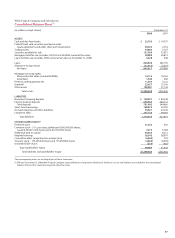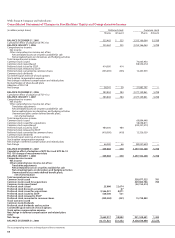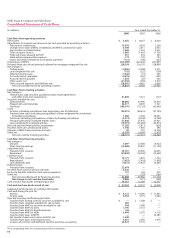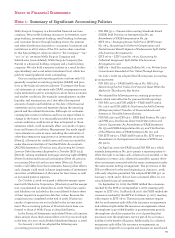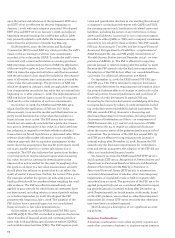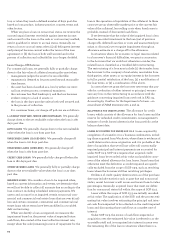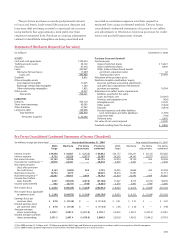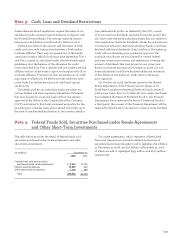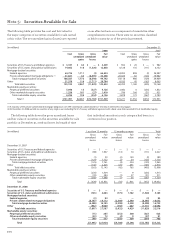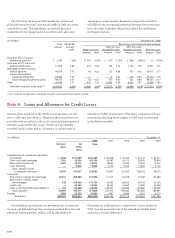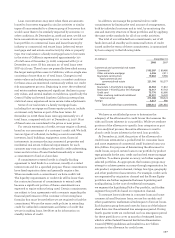Wells Fargo 2008 Annual Report Download - page 99
Download and view the complete annual report
Please find page 99 of the 2008 Wells Fargo annual report below. You can navigate through the pages in the report by either clicking on the pages listed below, or by using the keyword search tool below to find specific information within the annual report.
reasonable expectation about the timing and amount of cash
flows to be collected. The difference between contractually
required payments at acquisition and the cash flows expected
to be collected at acquisition, considering the impact of pre-
payments, is referred to as the nonaccretable difference.
Subsequent decreases to the expected cash flows will generally
result in a charge to the provision for credit losses resulting
in an increase to the allowance for loan losses. Subsequent
increases in cash flows result in reversal of nonaccretable
discount (or allowance for loan losses to the extent any had
been recorded) with a positive impact on interest income.
Disposals of loans, which may include sales of loans, receipt
of payments in full by the borrower, foreclosure, or troubled
debt restructurings result in removal of the loan from the
SOP 03-3 portfolio at its carrying amount.
Loans subject to SOP 03-3 are written down to an amount
estimated to be collectible. Accordingly, such loans are no
longer classified as nonaccrual even though they may be con-
tractually past due. We expect to fully collect the new carry-
ing values of such loans (that is, the new cost basis arising
out of purchase accounting). If a loan, or a pool of loans, dete-
riorates post acquisition a provision for loan losses is record-
ed to increase the allowance for loan losses. Loans subject to
SOP 03-3 are also excluded from the disclosure of loans 90
days or more past due and still accruing interest. Even
though substantially all of them are 90 days or more contrac-
tually past due, they are considered to be accruing because
the interest income on these loans relates to the establish-
ment of an accretable yield in accordance with SOP 03-3.
Securitizations and Beneficial Interests
In certain asset securitization transactions that meet the
applicable criteria to be accounted for as a sale, assets are sold
to an entity referred to as a qualifying special purpose entity
(QSPE), which then issues beneficial interests in the form of
senior and subordinated interests collateralized by the assets.
In some cases, we may retain up to 90% of the beneficial inter-
ests. Additionally, from time to time, we may also resecuritize
certain assets in a new securitization transaction.
The assets and liabilities sold to a QSPE are excluded from
our consolidated balance sheet, subject to a quarterly evalua-
tion to ensure the entity continues to meet the requirements to
be a QSPE. If our portion of the beneficial interests equals or
exceeds 90%, a QSPE would no longer qualify for off-balance
sheet treatment and we may be required to consolidate the
SPE, subject to determining whether the entity is a VIE and to
determining who is the primary beneficiary. In these cases, any
beneficial interests that we previously held are derecognized
from the balance sheet and we record the underlying assets
and liabilities of the SPE at fair value to the extent interests
were previously held by outside parties.
The carrying amount of the assets transferred to a QSPE,
excluding servicing rights, is allocated between the assets
sold and the retained interests based on their relative fair val-
ues at the date of transfer. We record a gain or loss in other
fee income for the difference between the carrying amount
and the fair value of the assets sold. Fair values are based on
quoted market prices, quoted market prices for similar assets,
or if market prices are not available, then the fair value is esti-
mated using discounted cash flow analyses with assumptions
for credit losses, prepayments and discount rates that are cor-
roborated by and independently verified against market
observable data, where possible. Retained interests from secu-
ritizations with off-balance sheet entities, including QSPEs and
VIEs where we are the primary beneficiary, are classified as
either available-for-sale securities, trading account assets or
loans, and are accounted for as described herein.
Mortgage Servicing Rights
Under FAS 156, Accounting for Servicing of Financial Assets –
an amendment of FASB Statement No. 140, servicing rights
resulting from the sale or securitization of loans we originate
(asset transfers) are initially measured at fair value at the date
of transfer. We recognize the rights to service mortgage loans
for others, or mortgage servicing rights (MSRs), as assets
whether we purchase the MSRs or the MSRs result from an
asset transfer. We determine the fair value of servicing rights
at the date of transfer using the present value of estimated
future net servicing income, using assumptions that market
participants use in their estimates of values. We use quoted
market prices when available to determine the value of other
interests held. Gain or loss on sale of loans depends on (1)
proceeds received and (2) the previous carrying amount of the
financial assets transferred and any interests we continue to
hold (such as interest-only strips) based on relative fair value
at the date of transfer.
To determine the fair value of MSRs, we use a valuation
model that calculates the present value of estimated future net
servicing income. We use assumptions in the valuation model
that market participants use in estimating future net servicing
income, including estimates of prepayment speeds (including
housing price volatility), discount rate, default rates, cost to
service (including delinquency and foreclosure costs), escrow
account earnings, contractual servicing fee income, ancillary
income and late fees. This model is validated by an indepen-
dent internal model validation group operating in accordance
with a model validation policy approved by the Corporate
Asset/Liability Management Committee (Corporate ALCO).
MORTGAGE SERVICING RIGHTS MEASURED AT FAIR VALUE We
have elected to initially measure and carry our MSRs related
to residential mortgage loans (residential MSRs) using the
fair value method. Under the fair value method, these resi-
dential MSRs are carried in the balance sheet at fair value
and the changes in fair value, primarily due to changes in
valuation inputs and assumptions and to the collection/
realization of expected cash flows, are reported in nonin-
terest income in the period in which the change occurs.
AMORTIZED MORTGAGE SERVICING RIGHTS Amortized MSRs,
which include commercial MSRs, are carried at the lower of
cost or market value. These MSRs are amortized in proportion
to, and over the period of, estimated net servicing income. The
amortization of MSRs is analyzed monthly and is adjusted to
reflect changes in prepayment speeds, as well as other factors.


